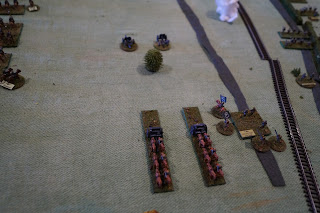I have made it back......
First Post for Quite a While
Boy, hasn't time flown. I have been flat out like a lizard drinking. I won't bore you with details, sufficed to say it has been a very productive time.
Amongst other things, I have been painting up an 1805 Russian Column for our Huge game in January.
Every year we have a large battle from some of Napoleon's array of battles. This year we are doing Austerlitz, which is going to be played on our biggest table yet. It nearly takes up a 4 car garage.....
I volunteered to buy and paint the 1st Column, on the Left Wing. Darren bought all the figures from Elite Miniatures and all of the other volunteers and I paid him and got to work. This was done in January or February, I think.... anyway, a little while ago.
I only have 3 Regiments to finish (they are mostly done, just collar, cuffs, shoulder straps and head wear, with their proper pom poms etc.)
I will post some pics of them in the next couple of weeks.
Meanwhile, I have been up to some money saving additions to my figures.
Firstly, I was watching some Youtube videos on how to make your own flock and grass clumps etc. and had a brainwave.......yes I know that you are supposed to have a brain to have one of those.... but instead of using traditional materials.... I would use.....wait for it......Dog Hair......
I have 2 Border Collies and they shed an enormous amount of hair. It gets blown about by the wind and ends up in clumps all around the back yard. We usually sweep it up and throw it away, but I started wondering if I could utilise this resource. I decided to test my theory out.....
I clamped some of the dog's hair between to ice cream (or iced lolly or whatever you call them) sticks.
You can see the black and white hairs here
I grabbed an old Folk Art paint, this one is called "Green Meadow"
I added some cheap floor polish, which is just as good as Future Floor polish, to loosen up the old paint and thin it down.
I dragged and swirled the hairs in the paint and polish solution and let it dry
I cut them into small strips, clamped them again and dipped one end in some PVA glue so that the strip doesn't fall apart.
Once the PVA glue is dry, you just pull of a small section and glue it into place using a blob of PVA glue. You will have to support the tuft for a little bit until the glue dries a little bit.
I was very happy with the result. Now to find some more uses for this valuable, and natural resource.
Not that I am a cheapskate or anything........
Another project I have been working on is the tassels on the end of flag poles. I could pay to get proper "Metal" ones, but that is not the way I roll. I love making things, so I thought about making my own.
I went to our local Lincraft store (or it could be any shop that sells cross stitch cottons and cotton thread) and bought some that matched as closely as I could get it.
I am using the silver for the Russians and I can use gold for British and anybody else who uses gold tassels on their flags.
I first cut some lengths of the cross stitch cotton, about 6 cm.
then I cut some smaller bits, about 1 and 1/2 to 2 cm long.
2 bits for each end of the longer thread
and tied the 2 bits together
I then pulled them so that both ends of the smaller bits were at the same end
Like so
I then tied those smaller bits onto the ends of the longer threads,
and tied the excess bits of cotton around and around the longer thread, like so
I super glued (or CA glued) the wound up excess cotton (trying hard not to stick my finger together)
Once the glue is dry, which won't take long, you may trim the ends to make them look a bit more in keeping with the scale
Like so
I super glued them to the flagpole, under the "Spike" of the flag, which I also made, from Tamiya Epoxy Putty
I then "painted" them with watered down PVA glue so that when they dry, they keep still
Here are some more pics to show you the result.
All in all, I was very pleased with my money saving techniques.
I will post some pics of my new Russians very shortly.
Until then,
Have fun everybody....and don't be scared to experiment,
Paul

















































































